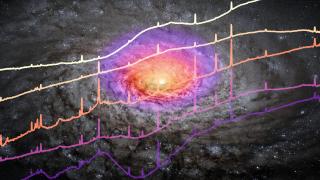Bibcode
García-Burillo, S.; Combes, F.; Ramos Almeida, C.; Usero, A.; Alonso-Herrero, A.; Hunt, L. K.; Rouan, D.; Aalto, S.; Querejeta, M.; Viti, S.; van der Werf, P. P.; Vives-Arias, H.; Fuente, A.; Colina, L.; Martín-Pintado, J.; Henkel, C.; Martín, S.; Krips, M.; Gratadour, D.; Neri, R.; Tacconi, L. J.
Bibliographical reference
Astronomy and Astrophysics
Advertised on:
12
2019
Journal
Citations
152
Refereed citations
141
Description
Aims: We investigate the fueling and the feedback of nuclear activity in the nearby (D = 14 Mpc) Seyfert 2 barred galaxy NGC 1068 by studying the distribution and kinematics of molecular gas in the torus and its connections to the host galaxy disk.
Methods: We used the Atacama Large Millimeter Array (ALMA ) to image the emission of a set of molecular gas tracers in the circumnuclear disk (CND) and the torus of the galaxy using the CO(2-1), CO(3-2), and HCO+(4-3) lines and their underlying continuum emission with high spatial resolutions (0.03″ - 0.09″ ≃ 2 - 6 pc). These transitions, which span a wide range of physical conditions of molecular gas (n(H2)⊂103 - 107 cm-3), are instrumental in revealing the density radial stratification and the complex kinematics of the gas in the torus and its surroundings.
Results: The ALMA images resolve the CND as an asymmetric ringed disk of D ≃ 400 pc in size and ≃1.4 × 108 M☉ in mass. The CND shows a marked deficit of molecular gas in its central ≃130 pc region. The inner edge of the ring is associated with the presence of edge-brightened arcs of NIR polarized emission, which are identified with the current working surface of the ionized wind of the active galactic nucleus (AGN). ALMA proves the existence of an elongated molecular disk/torus in NGC 1068 of Mtorusgas ≃ 3 × 105 M☉, which extends over a large range of spatial scales D ≃ 10 - 30 pc around the central engine. The new observations evidence the density radial stratification of the torus: the HCO+(4-3) torus, with a full size DHCO+(4 - 3) = 11 ± 0.6 pc, is a factor of between two and three smaller than its CO(2-1) and CO(3-2) counterparts, which have full sizes of DCO(3 - 2) = 26 ± 0.6 pc and DCO(2 - 1) = 28 ± 0.6 pc, respectively. This result brings into light the many faces of the molecular torus. The torus is connected to the CND through a network of molecular gas streamers detected inside the CND ring. The kinematics of molecular gas show strong departures from circular motions in the torus, the gas streamers, and the CND ring. These velocity field distortions are interconnected and are part of a 3D outflow that reflects the effects of AGN feedback on the kinematics of molecular gas across a wide range of spatial scales around the central engine. In particular, we estimate through modeling that a significant fraction of the gas inside the torus (≃ 0.4 - 0.6 × Mtorusgas) and a comparable amount of mass along the gas streamers are outflowing. However, the bulk of the mass, momentum, and energy of the molecular outflow of NGC 1068 is contained at larger radii in the CND region, where the AGN wind and the radio jet are currently pushing the gas assembled at the Inner Lindblad Resonance (ILR) ring of the nuclear stellar bar.
Conclusions: In our favored scenario a wide-angle AGN wind launched from the accretion disk of NGC1068 is currently impacting a sizable fraction of the gas inside the torus. However, a large gas reservoir (≃1.2 - 1.8 × 105 M☉), which lies close to the equatorial plane of the torus, remains unaffected by the feedback of the AGN wind and can therefore continue fueling the AGN for at least ≃1 - 4 Myr. Nevertheless, AGN fueling currently seems thwarted on intermediate scales (15 pc ≤r ≤ 50 pc).
Reduced datacubes and maps are only available at the CDS via anonymous ftp to http://cdsarc.u-strasbg.fr (ftp://130.79.128.5) or via http://cdsarc.u-strasbg.fr/viz-bin/cat/J/A+A/632/A61
Related projects

Nuclear Activity in Galaxies: a 3D Perspective from the Nucleus to the Outskirts
This project consists of two main research lines. First, the study of quasar-driven outflows in luminous and nearby obscured active galactic nuclei (AGN) and the impact that they have on their massive host galaxies (AGN feedback). To do so, we have been granted time with the Gran Telescopio CANARIAS (GTC) in the optical and near-infrared ranges
Cristina
Ramos Almeida